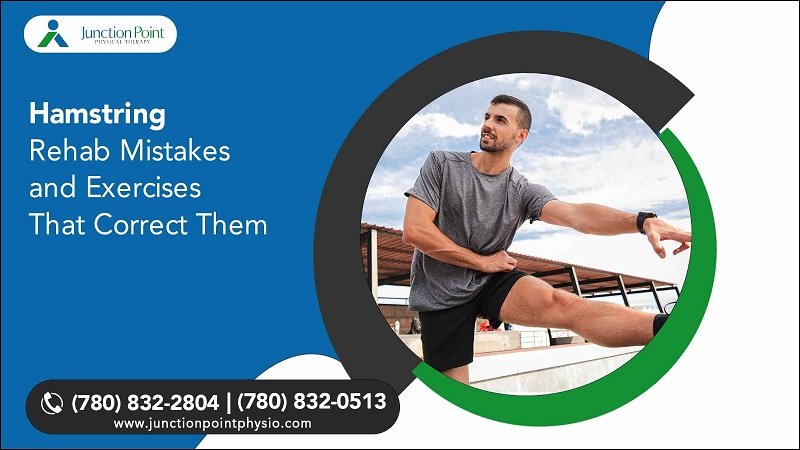There’s nothing like a hamstring injury to turn a casual sprint into an awkward hobble. While rest is essential, successful hamstring rehab is a calculated climb, not a long nap. A pulled hamstring isn’t just a soft-tissue mishap—it’s a signal that the body’s mechanics need a reset. This is where proper support, such as sports physiotherapy in Grande Prairie, helps shape a more effective recovery plan. Rehab missteps can prolong recovery and even lead to recurring injuries. But the good news? Avoiding these pitfalls and following science-backed strategies can help accelerate healing and maintain the hamstrings’ health over the long term.
Stretch, Sprint, Snap? Why Hamstring Injuries Need Strategic Rehabilitation
The hamstrings comprise three muscles—biceps femoris, semitendinosus, and semimembranosus. These muscles work together to power hip extension and knee flexion, which are key actions in walking, running, and jumping.
Common Causes of Hamstring Strains
Hamstring strains typically result from:
- Sudden acceleration or deceleration
- Overstretching the muscle during activity
- Muscle imbalance between the quads and hamstrings
Hamstring injuries require careful recovery; improper management can lead to chronic issues or re-tears, highlighting the importance of a structured physiotherapy approach for healing.
Top Hamstring Rehab Mistakes That Delay Recovery
Recovery from a hamstring injury requires a customized approach. Many athletes, however, fall into common pitfalls that slow healing or increase the risk of reinjury.
Mistake #1 – Resting Too Long
Although rest is initially essential to minimize inflammation and discomfort, prolonged inactivity compromises muscle integrity and slows the healing process. A gradual reintroduction of movement, particularly progressive loading, is crucial for restoring strength and resilience.
Mistake #2 – Ignoring Neuromuscular Training
Dedication to strength and flexibility without regard for coordination, balance, and agility may obstruct full recovery. The hamstrings need to be retrained to respond dynamically to movement, as experienced in everyday life, particularly in a specific sports context.
Mistake #3 – Returning to Sport Too Soon
Returning to sports too quickly without achieving the necessary strength and functional standards greatly increases the likelihood of reinjury. Functional testing, which compares strength, symmetry, and movement control, should guide the return-to-play process.
Mistake #4 – Skipping Eccentric Exercises
Eccentric exercises, in which the muscle lengthens under load, are central to restoring complete hamstring capacity. They are also crucial in avoiding future strains.
Mistake #5 – One-Size-Fits-All Approach
Hamstring rehabilitation should be individualized. The severity of the injury, the demands of the sport, and personal patterns of movement should all influence a custom recovery program to achieve maximum success.
Muscles on a Mission: Targeted Exercises That Correct Rehab Mistakes
Rehabilitation following a muscle injury, particularly in the hamstrings, may be complex. It’s not merely resting the damaged muscle; it’s rebuilding it to prevent future injury and restoring it to full functionality.
Eccentric Loading for Strength and Length
Nordic Hamstring Curls
This gold-standard exercise develops eccentric strength, especially in the susceptible distal portion of the hamstrings. Slowly lowering from the kneeling position while resisting the fall conditions the muscles for actual force absorption in life. The exercise strengthens the hamstrings’ ability to decelerate movement, enhancing performance and minimizing the risk of injury.
Romanian Deadlifts
This drill is also designed to load the hamstrings eccentrically, emphasizing the posterior chain. By bending at the hips with slightly bent knees, athletes load the hamstrings through a range of motion, increasing strength and flexibility while safeguarding against strain.
Sprint-Specific Rehab
High-Knee Drills and Resisted Sprinting
These drills rehabilitate dynamic function without stressing the recovering muscle. They reproduce sport movement patterns in conjunction with restoring timing, rhythm, and neuromuscular control. Resisted sprinting can enhance force generation and speed recovery, a must for competitors returning to game action.
Bounding and Skipping Drills
These plyometric actions recruit fast-twitch fibres of the glutes and hamstrings to provide explosive power and restore proper muscle firing patterns. Bounding drills enhance stride length and are specifically effective at returning athletes to high-intensity sprinting.
Glute and Core Activation
Bridges and Planks
Strengthening support muscles such as the glutes and core stabilizes the pelvis and minimizes compensatory movements that overwork the hamstrings. Additionally, glute bridges make hip extension easier, which is crucial for maintaining effective running form and preventing injuries.
Side-Lying Clamshells
This exercise also engages the gluteus medius, which helps maintain pelvic stability and promotes proper alignment during dynamic movements. Glute strengthening helps improve hamstring function and reduces lower back and hamstring strain during rehabilitation.
Isometric Strengthening
Hamstring Isometrics at 90 and 30 Degrees
These isometric holds are particularly beneficial in initial rehab stages. They establish the framework for developing eccentric and concentric strength by activating muscles without causing excessive movement. Athletes can prevent more injuries by improving muscle stability and control by holding themselves at specific joint angles.
Wall Sits
Wall sits engage the quadriceps, hamstrings, and glutes, building endurance and stability without excessive movement. The exercise strengthens the muscles required for prolonged lower-body activity, which is particularly valuable in the later stages of hamstring rehabilitation.
Physiotherapy Techniques That Accelerate Hamstring Recovery
Therapists employ methods such as manual therapy (including soft tissue mobilization, myofascial release, and massage) to reduce tightness, improve circulation, and facilitate movement. Dry needling, ultrasound, and TENS therapy help relieve trigger points and enhance blood flow, promoting tissue healing. In guided exercise prescription, sports physiotherapists in Grande Prairie establish a progressive rehab program for optimal healing without overloading the injury. Neuromuscular re-education helps retrain the brain and muscles to function in synchrony, thereby re-establishing movement patterns and preventing reinjury.
Get It Right and Get Back Out There
Successful hamstring rehabilitation is more than just repairing the muscle; it’s about preventing re-injury and enhancing overall performance. Athletes may recover more quickly and return to their sport in better shape by avoiding common rehab mistakes and including the right workouts. Sports physiotherapy in Grande Prairie, provided through personalized care, ensures a safe and complete recovery. Junction Point Physical Therapy offers one-on-one attention to support every step of the rehabilitation process. Schedule a consultation to initiate the healing process.

